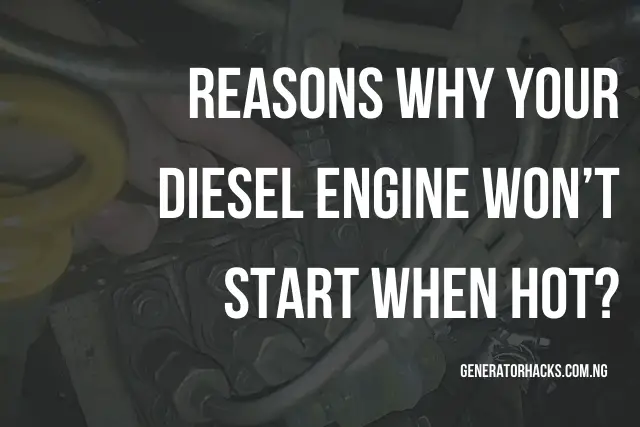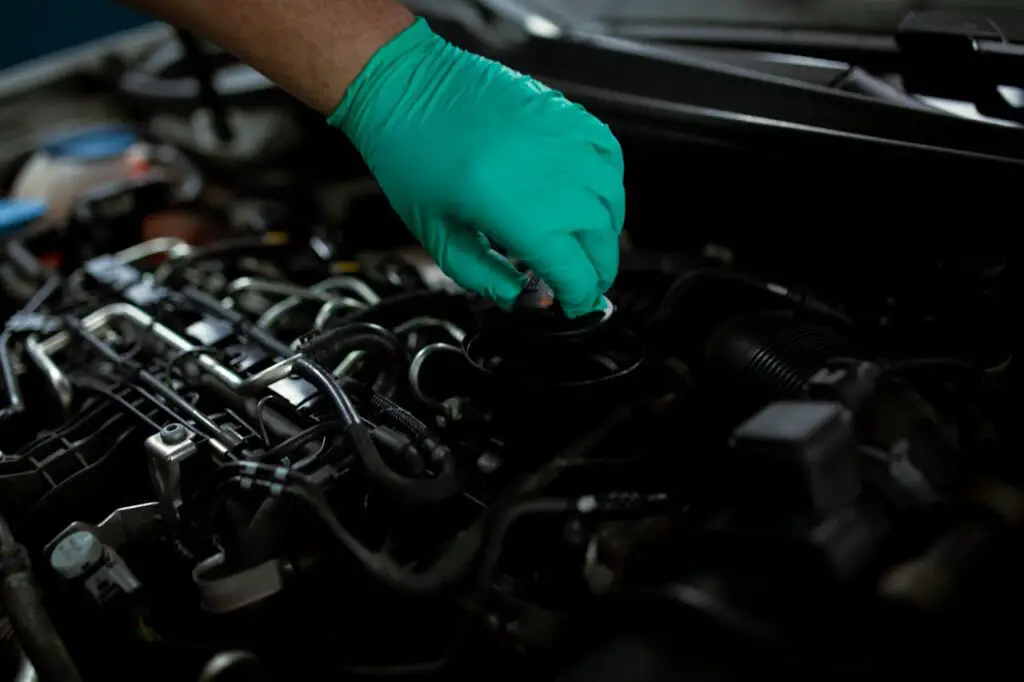As an Amazon Associate, we earn from qualifying purchases. This does not affect the price you pay or the quality of the products you buy. For more information, please read the full affiliate disclosure here.
Diesel engines operate differently from gasoline engines, relying on compression rather than spark plugs to initiate combustion.
One of the problems diesel engine owners mostly face is that the engine won’t start whenever it’s hot, which can be frustrating, especially if you’re using a diesel vehicle and you’re on a road trip or you’re running a generator that uses diesel.
Very few people have been able to answer this question because it’s something that doesn’t occur daily but once in a while. However, if you use your diesel vehicle frequently, you might have experienced it.
Starting a diesel engine when it’s hot tends to pose unique challenges for owners due to the excessive heat affecting the compression process. This can lead to difficulties in achieving the necessary conditions for combustion.
However, understanding the potential cause behind this issue and following a systematic troubleshooting approach can help you diagnose and resolve this problem effectively.
Reasons Why Your Diesel Engine Won’t Start When Hot?

There are various reasons why your diesel engine won’t start whenever it gets hot. Some of these reasons have to do with the fuel system, glow plug malfunction if you have one, overheating, electric system, etc.
1. Fuel System
The fuel system consists of various components, and if any of these parts have an issue, they will make your engine not start when hot. Some of these components include the injection pump, fuel filter, fuel pump, fuel lines, etc., and any other parts that have to do with your engine’s fuel.
a) Injection Pump Issues: The injection pump is an essential component of a diesel engine that requires regular inspection. Its primary function is to deliver fuel to the combustion chamber by metering the precise amount of fuel delivered to each nozzle during the injection cycle.
As a result of the tremendous amount of heat generated during operation, the injection pump of your engine may become worn over time. This can lead to reduced fuel pressure, internal leakage, or erratic metering, all of which can affect fuel delivery. Two types of injection pumps are available: mechanical pumps and electronic pumps.
Mechanical pumps are commonly found in older engines and may be more sensitive to heat-induced expansion, affecting their performance compared to modern electrical pumps. However, electric pumps may also develop faults. For example, the parts within the pump can be susceptible to heat, causing sensor malfunctions or even component failures, which can disrupt the precise fuel control needed for hot starts.
b) Clogged Fuel Filter: Sometimes, when your engine is cold and the fuel filter is clogged, it may still start. However, as the engine runs for longer and heats up, it will eventually stop starting altogether. A clogged fuel filter can become increasingly problematic and restrict fuel flow, especially when the engine is hot. This is because the injection pump requires sufficient fuel when hot to generate enough pressure to start.
On top of that, when a hot diesel engine is turned off, some fuel can soak back from the high-pressure side due to heat. This hot backflow can make things worse than you think with a clogged filter, even if there is more fuel readily available for restarting your diesel engine.
c) Air in the Fuel System: Air intrusion in your diesel fuel system can cause starting problems by disrupting the injector’s ability to properly atomize the fuel. This issue is typically caused by the fuel lines, which are often constructed from reinforced rubber or high-strength nylon to withstand the pressure and flow of fuel. Over time, exposure to high engine temperatures can weaken the lines, causing leaks or even ruptures. These leaks allow air to enter the system, which disrupts the fuel flow and air-fuel mixture that are necessary for starting the engine, particularly when it’s hot.
d) Fuel Pump: Unlike the injector pump, the primary function of fuel pumps is to transfer fuel from the tank to the injection pump at low pressure. Typically, the fuel pump is located near the fuel tanks but previously, they were made together with injection pumps. There are various types of these pumps, including mechanical life pumps and electrical fuel pumps.
In older engines, a single mechanical pump could perform both functions of transferring fuel and high-pressure injection. However, manufacturers have improved modern engines by separating the fuel pumps and injection pumps for better efficiency and control.
But here’s the issue: fuel pumps are made up of metal components. The pump housing and internal parts might expand slightly due to thermal expansion. This expansion can cause slight warping or misalignment within the pump, reducing its efficiency. In severe cases, excessive warping could lead to seized components or internal leaks.
Furthermore, fuel pumps also rely on various seals to prevent leaks and maintain proper pressure. As time goes on, these seals can become brittle or lose their elasticity due to heat exposure. Worn-out seals can allow fuel to leak internally, reducing pressure and hindering fuel delivery.
In extreme cases, especially with poor-quality fuel or a failing pump, heat can cause fuel to vaporize within the pump itself (vapor lock). Air bubbles can form within the fuel lines, preventing a steady flow of liquid fuel to the injectors. This vapor lock scenario can lead to complete engine stalling or difficulty starting when hot.
2. Glow Plug Malfunction
Not all engines use glow plugs, but for those that do, glow plugs are not a direct cause of hot start issues in diesel engines. Their main function is to assist in starting the engine in cold weather by heating the combustion chamber, which helps the fuel ignite more easily.
However, there may be an indirect connection. If the glow plugs are faulty (burned out, fouled, or have weak connections), they may not have properly pre-heated the engine during the previous cold start. This lack of pre-heating could lead to incomplete combustion and unburned fuel residuals within the cylinders. This unburned fuel can cause carbon deposits to build up on the glow plugs and injector nozzles, hindering their proper functioning and affecting fuel atomization and ignition, even when the engine is hot.
Moreover, incomplete combustion during the cold start can leave the engine block and cylinder head at a slightly lower temperature than usual. Though still considered “hot” compared to the ambient temperature, this slightly cooler engine may benefit from some pre-heating from the glow plugs, even during a hot start. Faulty glow plugs wouldn’t provide this assistance, potentially making hot starts slightly more difficult.
3. Electrical System Faults
The electric system can also cause your engine not to start when it is hot. The diesel electrical system consists of the battery, starter motor, and sensors.
a) Battery Issues: As time goes on, batteries lose their ability to hold a charge effectively. This reduced cranking power becomes more critical during hot starts, when the engine requires more power to overcome the heat-induced resistance. A weak battery might not be able to crank the engine fast enough to initiate proper combustion. Additionally, loose or corroded battery terminals can also create resistance in the electrical circuit, hindering the flow of current to the starter motor. This reduced current can also affect the starter’s ability to crank the engine effectively, especially when it is hot.
b) Starter Motor Problems: The starter motor itself is another reason why diesel engines won’t start when hot. As time goes on, they wear and tear down, leading to worn brushes, damaged windings, or a faulty solenoid. These internal problems make it harder for the starter motor to crank the engine forcefully, especially when it is hot. On top of that, the starter motor’s location near the engine exposes it to significant heat during hot starts. This heat soak can further reduce its cranking power and contribute to hot start difficulties.
c) Faulty Sensor Reading: Modern diesel engines rely on various sensors to monitor engine conditions and provide data to the Engine Control Unit (ECU). A faulty sensor, such as a crankshaft position sensor, can send incorrect information to the ECU, leading to improper fuel delivery or ignition timing. This can disrupt the delicate balance needed for starting, especially when hot. In some cases, extreme heat might even damage critical electrical components within the system. This could include the ECU itself or other electrical components crucial for starting the engine.
4. Overheating
Overheating is a serious issue that can cause significant damage to your diesel engine. Not only can it harm the internal components in the long run, but it can also make it harder to restart the engine once it’s hot.
When the engine gets too hot, the fuel inside it can vaporize, creating air bubbles within the pump or lines. This vapor lock can then hinder the proper flow of liquid fuel to the injectors, making it difficult for the engine to get the fuel it needs to start, especially when it’s hot.
Furthermore, the heat can weaken the fuel pump or damage seals within the fuel lines, leading to leaks and a decrease in overall fuel pressure. The engine requires optimal fuel pressure for starting, and a weakened system simply can’t deliver it when the engine is hot.
In extreme overheating scenarios, warped or melted components within the engine itself can seize and prevent the engine from cranking properly. This is a severe case and would require repairs beyond just addressing the hot start problem.
As the engine overheats, metal components can expand slightly, and this thermal expansion can tighten clearances between pistons, rings, and cylinder walls, increasing friction and making it even harder for the engine to turn over, especially during a hot start when additional cranking force is already needed.
ALSO READ: 8 Common Reasons Why Onan Generator Not Cranking and Solutions
Step-by-Step Troubleshooting Process

1. Check Fuel Delivery
Inspect all fuel lines, fittings, and connections for leaks and repair as necessary. Air intrusion can disrupt the fuel flow, leading to starting problems. Use a fuel line sealing compound or replace damaged components to ensure proper sealing.
Prime the fuel system to eliminate any air bubbles that may hinder proper fuel delivery. Consult the engine’s service manual for specific instructions on how to bleed the fuel system effectively.
Replace clogged fuel filters to ensure a consistent fuel flow. Additionally, consider using fuel additives that can help prevent the formation of deposits and improve the fuel’s cleanliness.
Additionally, you should test the fuel and injection pumps’ pressure and functionality. Seek professional assistance if required. Low fuel pressure can result in poor fuel atomization and start difficulties.
2. Inspect the Glow Plug Functionality
Inspect glow plugs for signs of damage or wear, replacing any that appear faulty. Ensure that the glow plugs are of the correct type and specifications for your engine model.
Test the glow plugs for proper electrical continuity and heating capacity. Use an ohmmeter to check the resistance of each glow plug. If the resistance is significantly higher than the manufacturer’s specifications, which typically fall between 1Ω and 6Ω, replace the faulty glow plugs.
Additionally, clean or replace malfunctioning glow plugs and ensure the electrical connections are secure. Corroded or loose connections can prevent the glow plugs from receiving adequate power.
3. Assess the Electrical System
It is important to inspect the battery terminals and connections thoroughly for any corrosion or looseness. If there are any, clean or tighten them as required. Corrosion can obstruct the flow of electrical current, which can affect the starting performance of your engine.
To ensure that your battery is functioning optimally, it is recommended to test its voltage and charging system. Using a multimeter, measure the battery voltage. A healthy battery should read around 12.4–12.8 volts when not running. If the voltage is significantly lower (below 12 volts), the battery might be weak and contribute to hot start issues.
It is also important to check the starter motor’s operation for any signs of wear or damage. If you notice any issues, it is recommended to consider professional inspection and repair services. Inspect the starter motor for physical damage, such as worn brushes or a damaged commutator. Additionally, make sure that the starter motor is securely mounted and that the electrical connections are tight.
If you are using a modern diesel engine, it is recommended to check the sensor reading with a multimeter as well. If you are not capable of doing it yourself, it is recommended that you seek professional assistance.
4. Address Overheating Issues
It is important to regularly check the coolant level when the engine is cool. Never attempt to open a hot radiator cap. If the coolant level is low, add the recommended coolant from the manufacturer. Low coolant levels can cause overheating, which can lead to starting issues once the engine reaches the operating temperature. Check for any signs of coolant leaks around the radiator, hoses, and engine block. Cracks, loose connections, or worn hoses can all contribute to coolant loss and overheating. Be sure to repair any leaks promptly to maintain proper coolant levels.
Inspect the radiator for debris such as leaves, bugs, or road grime. These can accumulate and obstruct the proper airflow through the fins. Use compressed air or a soft brush to clean the radiator fins regularly and remove any dirt or debris that may hinder heat dissipation. If the radiator is damaged beyond repair, it is advisable to replace it to ensure optimal cooling efficiency.
Make sure all cooling system components are functioning correctly. A malfunctioning thermostat can get stuck closed, preventing the engine coolant from reaching the radiator for proper cooling. Conversely, a stuck-open thermostat might allow coolant to flow too freely, preventing the engine from reaching optimal operating temperature. A worn water pump might not circulate the coolant adequately throughout the engine, leading to overheating. If you suspect a faulty thermostat or water pump, consult a repair manual for testing procedures or have a qualified mechanic diagnose the issue. Replace any faulty components as necessary to maintain a proper engine operating temperature and prevent hot start problems.
ALSO READ: Diesel Engine Turning Over but Not Starting: What Are the Causes and How to Fix Them?
Maintenance Tips to Prevent Hot-Starting Problems
- Adhere to the manufacturer’s recommended maintenance schedule for your diesel engine, including regular servicing and inspections. Following the recommended maintenance intervals ensures that potential issues are addressed before they lead to problems.
- Replace fuel filters at the specified intervals to ensure optimal fuel flow. Regularly inspect the fuel system for any signs of leaks or contamination and address them promptly.
- Keep the cooling system clean and well-maintained to prevent overheating issues. Regularly flush the cooling system and replace the coolant according to the manufacturer’s recommendations. Inspect the radiator and other cooling system components for any signs of damage or wear.
- Test and replace glow plugs as recommended by the manufacturer. Glow plugs have a limited lifespan, and replacing them at the specified intervals ensures efficient starting performance.
- Maintain a healthy electrical system by regularly checking the battery and starter motor’s condition. Clean the battery terminals, ensure secure connections, and test the battery’s voltage regularly. Inspect the starter motor for any signs of wear or damage and address issues promptly.
- Avoid prolonged idling, as it can contribute to excessive heat buildup in the engine. If you need to keep the engine running for an extended period, consider using a high-idle feature if available or periodically revving the engine to maintain proper operating temperatures.
ALSO READ: Can You Use Starter Fluid on a Diesel Engine?
Final Thought
Experiencing difficulty starting a diesel engine when it’s hot can be frustrating, but with a systematic troubleshooting approach, you can identify and resolve the underlying causes. To improve the hot-starting performance of your diesel engine, you should address fuel system issues, check and maintain glow plugs, evaluate the electrical system, and prevent overheating. It is important to follow the manufacturer’s recommendations for maintenance and consult with professionals when necessary. By implementing these steps and maintaining a proactive approach to diesel engine care, you can ensure a seamless starting experience, even in hot conditions. This will help you keep your diesel engine running smoothly for years to come.
Share


